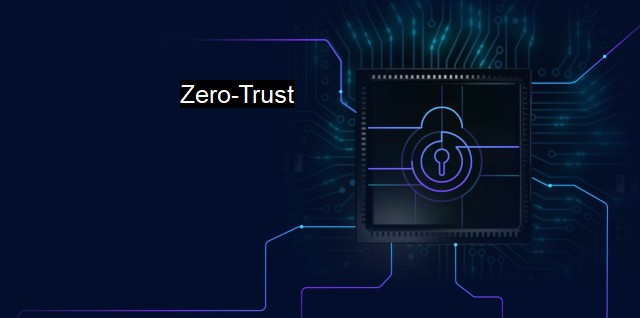What is Zero-Trust?
Zero-Trust Security: A Holistic Approach to Combat Modern Cyber-Threats
Zero-trust is a key cybersecurity concept that's quickly becoming pertinent for businesses operating both in the physical and digital domains. Given its importance today, understanding what it comprises is imperative for businesses, particularly as they seek a meaningful resolution to the increasing number of cybersecurity-related compromises that assail them from all sides.In its simplest definition, zero-trust is a security model premised on the belief that no user or device should automatically be trusted, regardless of whether they exist inside or outside of the network perimeter. the zero-trust model operates off the axiom "never trust, always verify," ensuring that irrespective of the machine, entity, or application trying to gain access to specific areas of an organization’s system, it would first need to prove its legitimacy before such access is granted.
This concept stands in contrast with the traditional cybersecurity model where everything within an organization's network was wholly trusted. As the upsurge in the number of data breaches over the past few years clearly show, this old model is increasingly unreliable. It was susceptible to various forms of compromises, predominantly because once an unauthorized user gained access to the system, they often had a free rein to explore without limitations.
Zero-trust, on the other hand, eliminates this risk through a rigorous identity verification procedure required for each individual striving to access system resources. This comprehensive authentication process remains constant irrespective of the source's origin or its previous verification status. It ensures every layer of the organization's infrastructure is safeguarded.
Zero-trust builds upon various principles and technologies. The primary one is that of least-privilege access. It gives users just enough access rights to accomplish their tasks, and when those actions are finished, those rights are revoked. By limiting access priviledges, it vastly reduces the attack surface, diminishing the opportunity for malicious actors to exploit valuable resources.
Another noteworthy principle is micro-segmentation, wherein the organization's existing network is divided into small, isolated segments. Each segment functions independently of one another, thus allowing policies to be instituted and tailored much more restrictively.
Various technologies facilitate the zero-trust model, with multi-factor authentication (MFA) being especially critical. MFA practices provide extra verifiability, meaning that even if a malicious actor steals a user's singular access (i.e., password), the chances of them infiltrating the system still remain low without the other factors of authentication.
Artificial intelligence and machine learning also play roles in zero-trust, helping automate processes and enlist user and entity behavior analytics for anomaly detection. Transactional scoring and risk-based access controls are significant elements as they provide a context-rich and real-time grounding for decision-making.
The zero-trust concept has found a particular ally in the expanding world of antivirus software. Where traditional antivirus software relies largely upon pattern recognition to function, the inherently naive trust model often leaves systems vulnerable to new or modified threats. With an adoption of the zero-trust model, antivirus software would consider every file as potentially harmful until explicitly proven otherwise.
While the zero-trust model might require an overhaul of the existing network infrastructure, its practicality in addressing current cybersecurity challenges is increasingly evident. It revolves around a paradigm shift from automatic trust to rigorous verification, ensuring safer environments for digital assets. Operating strictly on the maxim of “never trust, always verify”, the zero-trust concept provides an answer to containing and preventing unauthorized access in intranets. For cybersecurity experts and antivirus pundits, this could be the game-changer in the ongoing battle against cyber threats and data breaches.

Zero-Trust FAQs
What is zero-trust in cybersecurity?
Zero-trust is a security approach that assumes that every user or device attempting to access a network is malicious, and it doesn't automatically trust anyone or anything. Instead, it verifies and validates every access request, regardless of where it comes from or the user's identity.How does zero-trust differ from traditional network security?
Traditional network security typically relies on a firewall to secure data and devices within a network perimeter. In contrast, zero-trust security requires continuous verification of users, devices, and applications, regardless of their location or network perimeter.What are the benefits of zero-trust in cybersecurity?
Zero-trust provides a more secure and transparent approach to network security that reduces the risk of data breaches and cyberattacks. It also improves flexibility and reduces complexity by allowing users to access data and resources from any location and device securely.What are some best practices for implementing zero-trust security?
Some best practices for implementing zero-trust security include identifying and classifying sensitive data, limiting access to only necessary users, monitoring and logging activity, and regularly assessing and updating security protocols. It is also important to foster a culture of security awareness and provide ongoing training for employees.Related Topics
Network Segmentation Identity and Access Management (IAM) Multi-Factor Authentication (MFA) Endpoint Security Security Information and Event Management (SIEM)
| | A | | | B | | | C | | | D | | | E | | | F | | | G | | | H | | | I | | | J | | | K | | | L | | | M | |
| | N | | | O | | | P | | | Q | | | R | | | S | | | T | | | U | | | V | | | W | | | X | | | Y | | | Z | |
| | 1 | | | 2 | | | 3 | | | 4 | | | 7 | | | 8 | | |||||||